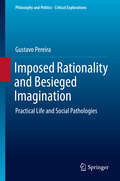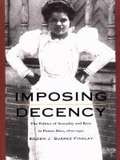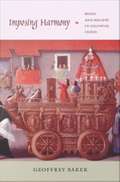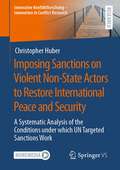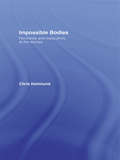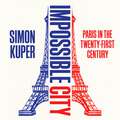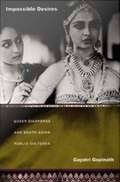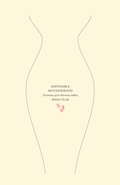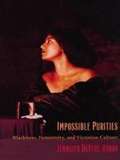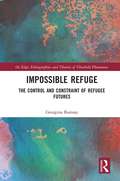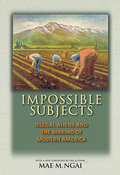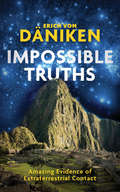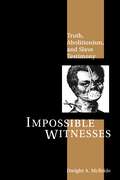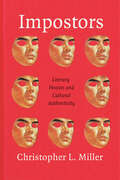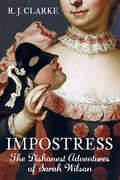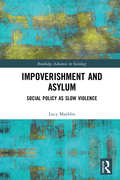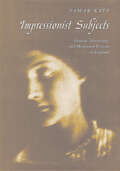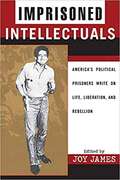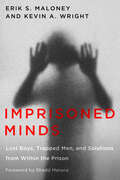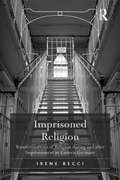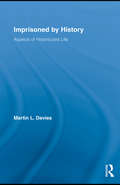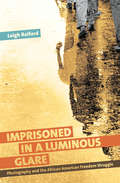- Table View
- List View
Imposed Rationality and Besieged Imagination: Practical Life and Social Pathologies (Philosophy and Politics - Critical Explorations #9)
by Gustavo PereiraSocial pathologies are social processes that hinder how individuals exercise their autonomy and freedom. In this book, Gustavo Pereira offers an account of such phenomena by defining them as a cognitive failure that affects the practical imagination, thus negatively interfering with our practical life. This failure of the imagination is the consequence of the imposition of a type of practical rationality on a practical context alien to it, caused by a non‑conscious transformation of the individuals’ set of beliefs and values. The research undertaken provides an innovative explanation in terms of microfoundations based on the mechanism of “availability heuristic”, by which the diminished exercise of the imagination turns the intuitively available or prevailing rationality into the one that regulates behaviour in inappropriate contexts. Additionally, this incorrect regulation results in a progressive distortion of the shared sense of the affected practical contexts, which becomes institutionalized. Consumerism, bureaucratism, moralism, juridification, some forms of corruption and the particular Latin American case of “malinchism” can be interpreted as social pathologies insofar as they imply such distortion. This way of conceptualizing social pathologies integrates the traditional sociological macro‑explanation manifested through the negative consequences of the processes of social rationalization with a micro‑explanation articulated around the findings of cognitive psychology such as availability heuristic. Understanding social pathologies as a cognitive failure allows us to identify the introduction of normative friction as the main way to counteract their effects. One of the potential effects of normative friction, as a specific form of cognitive dissonance, is the intense exercise of the imagination, thus operating as a condition of possibility for the exercise of autonomy and reflection. Democratic ethical life, understood as a shared democratic culture, as well as social institutions and narratives, are the privileged social spaces and means to trigger reflective processes that can counteract social pathologies through a reflective reappropriation of the meaning of the shared practical context. An extraordinary contribution by a Critical Theorist to the return of the concept of imagination today. It takes up the challenge once taken by Kant to think about imagination as the pivotal activity not only of knowledge and experience, but above all, for action. The author claims that imagination makes criticism possible (pathologies) and it allows us to envision alternative views into the path for social transformation. Without imagination nothing is possible. María Pía Lara, Universidad Autónoma Metropolitana-Iztapalapa, Mexico
Imposing Decency: The Politics of Sexuality and Race in Puerto Rico, 1870–1920
by Eileen J. FindlayFeminists, socialists, Afro-Puerto Rican activists, and elite politicians join laundresses, prostitutes, and dissatisfied wives in populating the pages of Imposing Decency. Through her analyses of Puerto Rican anti-prostitution campaigns, attempts at reforming marriage, and working-class ideas about free love, Eileen J. Suárez Findlay exposes the race-related double standards of sexual norms and practices in Puerto Rico between 1870 and 1920, the period that witnessed Puerto Rico's shift from Spanish to U.S. colonialism. In showing how political projects and alliances in Puerto Rico were affected by racially contingent definitions of "decency" and "disreputability," Findlay argues that attempts at moral reform and the state's repression of "sexually dangerous" women were weapons used in batttles between elite and popular, American and Puerto Rican, and black and white. Based on a thorough analysis of popular and elite discourses found in both literature and official archives, Findlay contends that racialized sexual norms and practices were consistently a central component in the construction of social and political orders. The campaigns she analyzes include an attempt at moral reform by elite male liberals and a movement designed to enhance the family and cleanse urban space that ultimately translated into repression against symbollically darkened prostitutes. Findlay also explores how U.S. officials strove to construct a new colonial order by legalizing divorce and how feminist, labor, and Afro-Puerto Rican political demands escalated after World War I, often focusing on the rehabilitation and defense of prostitutes. Imposing Decency forces us to rethink previous interpretations of political chronologies as well as reigning conceptualizations of both liberalism and the early working-class in Puerto Rico. Her work will appeal to scholars with an interest in Puerto Rican or Latin American studies, sexuality and national identity, women in Latin America, and general women's studies.
Imposing Harmony: Music and Society in Colonial Cuzco
by Geoffrey BakerImposing Harmony is a groundbreaking analysis of the role of music and musicians in the social and political life of colonial Cuzco. Challenging musicology's cathedral-centered approach to the history of music in colonial Latin America, Geoffrey Baker demonstrates that rather than being dominated by the cathedral, Cuzco's musical culture was remarkably decentralized. He shows that institutions such as parish churches and monasteries employed indigenous professional musicians, rivaling Cuzco Cathedral in the scale and frequency of the musical performances they staged. Building on recent scholarship by social historians and urban musicologists and drawing on extensive archival research, Baker highlights European music as a significant vehicle for reproducing and contesting power relations in Cuzco. He examines how Andean communities embraced European music, creating an extraordinary cultural florescence, at the same time that Spanish missionaries used the music as a mechanism of colonialization and control. Uncovering a musical life of considerable and unexpected richness throughout the diocese of Cuzco, Baker describes a musical culture sustained by both Hispanic institutional patrons and the upper strata of indigenous society. Mastery of European music enabled elite Andeans to consolidate their position within the colonial social hierarchy. Indigenous professional musicians distinguished themselves by fulfilling important functions in colonial society, acting as educators, religious leaders, and mediators between the Catholic Church and indigenous communities.
Imposing Sanctions on Violent Non-State Actors to Restore International Peace and Security: A Systematic Analysis of the Conditions under which UN Targeted Sanctions Work (Innovative Konfliktforschung – Innovation in Conflict Research)
by Christopher HuberIn the last decades, violent non-state actors (VNSAs) such as rebel and terrorist organizations have proved their capacity to break international law. The international community, particularly the United Nations (UN), has reacted to this development by redirecting its conflict resolution efforts to these non-state entities. This has turned targeted sanctions into one of the most vital and indispensable foreign policy tools available to the UN Security Council in combating terrorism and contributing to the peaceful resolution of (intra-state) conflicts. Despite the UN Security Council’s growing tendency to sanction VNSAs, there has been little research analyzing the effects of UN targeted sanctions on these non-government actors. This book seeks to fill this gap and shifts the focus on non-state actors by ascertaining the general mechanisms through and conditions under which UN targeted sanctions imposed on VNSAs tend to be effective. The tripartite empirical analysis combining quantitative and qualitative research methods demonstrates that the state-centric understanding of how sanctions work is not simply applicable to the effective sanctioning of violent non-state actors such as rebel and terrorist movements.
Impossible Bodies: Femininity and Masculinity at the Movies (Comedia)
by Christine HolmlundImpossible Bodies investigates issues of ethnicity, gender, and sexuality in contemporary Hollywood. Examining stars from Arnold Schwarzenegger and Clint Eastwood, to Whoopi Goldberg and Jennifer Lopez, Holmlund focuses on actors whose physique or appearance marks them as unusual or exceptional, and yet who occupy key and revealing positions in today's mainstream cinema. Exploring a range of genres and considering both stars and their sidekicks, Holmlund examines ways in which Hollywood accommodates - or doesn't - a variety of 'impossible' bodies, from the 'outrageous' physiques of Dolph Lundgren and Dolly Parton, to the almost-invisible bodies of Asian-Americans, Latinas and older actors.
Impossible Citizens: Dubai's Indian Diaspora
by Neha VoraIndian communities have existed in the Gulf emirate of Dubai for more than a century. Since the 1970s, workers from South Asia have flooded into the emirate, enabling Dubai's huge construction boom. They now compose its largest noncitizen population. Though many migrant families are middle-class and second-, third-, or even fourth-generation residents, Indians cannot become legal citizens of the United Arab Emirates. Instead, they are all classified as temporary guest workers. In Impossible Citizens, Neha Vora draws on her ethnographic research in Dubai's Indian-dominated downtown to explore how Indians live suspended in a state of permanent temporariness. While their legal status defines them as perpetual outsiders, Indians are integral to the Emirati nation-state and its economy. At the same time, Indians--even those who have established thriving diasporic neighborhoods in the emirate--disavow any interest in formally belonging to Dubai and instead consider India their home. Vora shows how these multiple and conflicting logics of citizenship and belonging contribute to new understandings of contemporary citizenship, migration, and national identity, ones that differ from liberal democratic models and that highlight how Indians, rather than Emiratis, are the quintessential--yet impossible--citizens of Dubai.
Impossible City: Paris in the Twenty-First Century
by Simon KuperFrom the bestselling author of Chums comes an explorer's tale of a naïf eventually getting to understand a complex, glittering, beautiful and often cruel society - at least a little.Simon Kuper has experienced Paris both as a human being and as a journalist. He has grown middle-aged there, eaten the croissants, seen his wife through life-threatening cancer, taken his children to countless football matches on freezing Saturday mornings in the city's notorious banlieues, and in 2015 lived through two terrorist attacks on their neighbourhood. Over two decades of becoming something of a cantankerous Parisian himself, Kuper has watched the city change.This century, it has globalised, gentrified, and been shocked into realising its role as the crucible of civilizational conflict. Sometimes it's a multicultural paradise, and sometimes it isn't. This decade, Parisians have lived through a sequence of shocks: terrorist attacks, record floods and heatwaves, the burning of Notre Dame, the storming of the city by gilets jaunes, and then the pandemic. Now, as the Olympics come to town, France is busy executing the "Grand Paris" project: the most serious attempt yet to knit together the bejewelled city with its neglected suburbs.This is a captivating memoir of the Paris of today, without the Parisian clichés.
Impossible Desires: Queer Diasporas and South Asian Public Cultures
by Gayatri GopinathBy bringing queer theory to bear on ideas of diaspora, Gayatri Gopinath produces both a more compelling queer theory and a more nuanced understanding of diaspora. Focusing on queer female diasporic subjectivity, Gopinath develops a theory of diaspora apart from the logic of blood, authenticity, and patrilineal descent that she argues invariably forms the core of conventional formulations. She examines South Asian diasporic literature, film, and music in order to suggest alternative ways of conceptualizing community and collectivity across disparate geographic locations. Her agile readings challenge nationalist ideologies by bringing to light that which has been rendered illegible or impossible within diaspora: the impure, inauthentic, and nonreproductive. Gopinath juxtaposes diverse texts to indicate the range of oppositional practices, subjectivities, and visions of collectivity that fall outside not only mainstream narratives of diaspora, colonialism, and nationalism but also most projects of liberal feminism and gay and lesbian politics and theory. She considers British Asian music of the 1990s alongside alternative media and cultural practices. Among the fictional works she discusses are V. S. Naipaul's classic novel A House for Mr. Biswas, Ismat Chughtai's short story "The Quilt," Monica Ali's Brick Lane, Shyam Selvadurai's Funny Boy, and Shani Mootoo's Cereus Blooms at Night. Analyzing films including Deepa Mehta's controversial Fire and Mira Nair's Monsoon Wedding, she pays particular attention to how South Asian diasporic feminist filmmakers have reworked Bollywood's strategies of queer representation and to what is lost or gained in this process of translation. Gopinath's readings are dazzling, and her theoretical framework transformative and far-reaching.
Impossible Motherhood
by Robin Morgan Irene VilarIrene Vilar was just a pliant young college undergraduate in thrall to her professor when they embarked on a relationship that led to marriage--a union of impossible odds--and fifteen abortions in fifteen years. Vilar knows that she is destined to be misunderstood, that many will see her nightmare as an instance of abusing a right, of using abortion as a means of birth control. But it isn't that. The real story is part of an awful secret, shrouded in shame, colonialism, self-mutilation, and a family legacy that features a heroic grandmother, a suicidal mother, and two heroin-addicted brothers. It is a story that looks back on her traumatic childhood growing up in the shadow of her mother's death and the footsteps of her famed grandmother, the political activist Lolita Lebrón, and a history that touches on American exploitation and reproductive repression in Puerto Rico. Vilar seamlessly weaves together past, present, and future, channeling a narrative that is at once dramatic and subtle.Impossible Motherhood is a heartrending and ultimately triumphant testimonial told by a writer looking back on her history of addiction. Abortion has never offered any honest person easy answers. Vilar's dark journey through self-inflicted wounds, compulsive patterns, and historical hauntings is a powerful story of loss and mourning that bravely delves into selfhood, national identity, reproductive freedom, family responsibility, and finally motherhood itself--today, Vilar is the mother of two beautiful children.From the Trade Paperback edition.
Impossible Purities: Blackness, Femininity, and Victorian Culture
by Jennifer Devere BrodyUsing black feminist theory and African American studies to read Victorian culture, Impossible Purities looks at the construction of "Englishness" as white, masculine, and pure and "Americanness" as black, feminine, and impure. Brody's readings of Victorian novels, plays, paintings, and science fiction reveal the impossibility of purity and the inevitability of hybridity in representations of ethnicity, sexuality, gender, and race. She amasses a considerable amount of evidence to show that Victorian culture was bound inextricably to various forms and figures of blackness. Opening with a reading of Daniel Defoe's "A True-Born Englishman," which posits the mixed origins of English identity, Brody goes on to analyze mulattas typified by Rhoda Swartz in William Thackeray's Vanity Fair, whose mixed-race status reveals the "unseemly origins of English imperial power." Examining Victorian stage productions from blackface minstrel shows to performances of The Octoroon and Uncle Tom's Cabin, she explains how such productions depended upon feminized, "black" figures in order to reproduce Englishmen as masculine white subjects. She also discusses H.G. Wells's The Island of Dr. Moreau in the context of debates about the "new woman," slavery, and fears of the monstrous degeneration of English gentleman. Impossible Purities concludes with a discussion of Bram Stoker's novella, "The Lair of the White Worm," which brings together the book's concerns with changing racial representations on both sides of the Atlantic.This book will be of interest to scholars in Victorian studies, literary theory, African American studies, and cultural criticism.
Impossible Refuge: The Control and Constraint of Refugee Futures (On Edge: Ethnographies and Theories of Threshold Phenomena)
by Georgina RamsayImpossible Refuge brings the perspectives of refugees into rapidly emerging dialogues about contemporary situations of mass forced migration, asking: what does it mean to be displaced? Based on multi-sited ethnographic research conducted with refugees from Central Africa living in situations of protracted asylum in Uganda and resettlement in Australia, the book provides a unique comparative analysis of global humanitarian systems and the experiences of refugees whose lives are interwoven with them. The book problematises the solutions that are currently in place to resolve the displacement of refugees, considering that since displacement cannot be reduced to a politico-legal problem but is an experience that resonates at an existential level, it cannot be assumed that politico-legal solutions to displacement automatically resolve what is, fundamentally, an existential state of being. Impossible Refuge therefore offers a new theoretical foundation through which to think about the experiences of refugees, as well as the systems in place to manage and resolve their displacement. The book argues that the refuge provided to refugees through international humanitarian systems is conditional: requiring that they conform to lifestyles that benefit the hegemonic future horizons of the societies that host and receive them. Impossible Refuge calls for new ways of approaching displacement that go beyond the exceptionality of refugee experience, to consider instead how the contestation and control of possible futures makes displacement a general condition of our time. As such, it will appeal to scholars across the social sciences with interests in migration and refugees, humanitarianism and violence, sovereignty and citizenship, cosmology and temporality, and African studies, broadly.
Impossible Returns: Narratives of the Cuban Diaspora
by Iraida H. LopezIn this one-of-a-kind volume, Iraida López explores various narratives of return by those who left Cuba as children or adolescents. Including memoirs, semi-autobiographical fiction, and visual arts, many of these accounts feature a physical arrival on the island while others depict a metaphorical or vicarious experience by means of fictional characters or childhood reminiscences. As two-way migration increases in the post-Cold War period, many of these narratives put to the test the boundaries of national identity. Through a critical reading of works by Cuban American artists and writers like María Brito, Ruth Behar, Carlos Eire, Cristina García, Ana Mendieta, Gustavo Pérez Firmat, Ernesto Pujol, Achy Obejas, and Ana Menéndez, López highlights the affective ties as well as the tensions underlying the relationship between returning subjects and their native country. Impossible Returns also looks at how Cubans still living on the island depict returning émigrés in their own narratives, addressing works by Jesús Díaz, Humberto Solás, Carlos Acosta, Nancy Alonso, Leonardo Padura, and others. Blurring the lines between disciplines and geographic borders, this book underscores the centrality of Cuba for its diaspora and bears implications for other countries with widespread populations in exile.
Impossible Subjects
by Mae M. NgaiThis book traces the origins of the "illegal alien" in American law and society, explaining why and how illegal migration became the central problem in U.S. immigration policy--a process that profoundly shaped ideas and practices about citizenship, race, and state authority in the twentieth century. Mae Ngai offers a close reading of the legal regime of restriction that commenced in the 1920s--its statutory architecture, judicial genealogies, administrative enforcement, differential treatment of European and non-European migrants, and long-term effects. She shows that immigration restriction, particularly national-origin and numerical quotas, remapped America both by creating new categories of racial difference and by emphasizing as never before the nation's contiguous land borders and their patrol.Some images inside the book are unavailable due to digital copyright restrictions.
Impossible Truths: Amazing Evidence of Extraterrestrial Contact
by Erich Von DanikenA highly readable introduction to Erich von Däniken’s astounding theories about alien contact with the Earth from earliest times, updated with new evidence from his research into formerly inaccessible sites.Why do flying machines and astronauts appear in the artworks and sacred texts of all ancient cultures? What is the meaning of the immense earth drawings, impossible to view from the ground, that can be found all over the globe? How could prehistoric cultures have engraved diorite and other hard rock with such incredible precision without the use of modern tools? In this mind-bending new book, Erich von Däniken draws on his latest research to update his astounding theory that the inhabitants of other planets have kept in contact with humankind since the earliest times. • Assess for yourself the stunning visual evidence presented in some 200 photographs. • Examine previously unpublished testimony from expert informants. • Discover new research undertaken by von Däniken after the opening up of previously inaccessible regions, such as the jungle city “Buritaca 200” in Colombia.
Impossible Witnesses: Truth, Abolitionism, and Slave Testimony
by Dwight McBrideEven the most cursory review of black literary production during the nineteenth century indicates that its primary concerns were the issues of slavery, racial subjugation, abolitionist politics and liberation. How did the writers of these narratives "bear witness" to the experiences they describe? At a time when a hegemonic discourse on these subjects already existed, what did it mean to "tell the truth" about slavery? Impossible Witnesses explores these questions through a study of fiction, poetry, essays, and slave narratives from the abolitionist era. Linking the racialized discourses of slavery and Romanticism, it boldly calls for a reconfiguration of U.S. and British Romanticism that places slavery at its center. Impossible Witnesses addresses some of the major literary figures and representations of slavery in light of discourses on natural rights and law, offers an account of Foucauldian discourse analysis as it applies to the problem of "bearing witness," and analyzes specific narratives such as "Narrative of the Life of Frederick Douglass," and "The Interesting Narrative of the Life of Olaudah Equiano." A work of great depth and originality, Impossible Witnesses renders traditional interpretations of Romanticism impossible and places Dwight A. McBride at the forefront of studies in race and literature.
Impostors: Literary Hoaxes and Cultural Authenticity
by Christopher L. Miller“Miller takes us on an exciting tour of postcolonial and world literature, guiding us through the literary maze of the real and the pretenders to the real.” —Ngugi wa Thiong’o, author of Wizard of the CrowWriting a new page in the surprisingly long history of literary deceit, Impostors examines a series of literary hoaxes, deceptions that involved flagrant acts of cultural appropriation. This book looks at authors who posed as people they were not, in order to claim a different ethnic, class, or other identity. These writers were, in other words, literary usurpers and appropriators who trafficked in what Christopher L. Miller terms the “intercultural hoax.”In the United States, such hoaxes are familiar. Forrest Carter’s The Education of Little Tree and JT LeRoy’s Sarah are two infamous examples. Miller’s contribution is to study hoaxes beyond our borders, employing a comparative framework and bringing French and African identity hoaxes into dialogue with some of their better-known American counterparts. In France, multiculturalism is generally eschewed in favor of universalism, and there should thus be no identities (in the American sense) to steal. However, as Miller demonstrates, this too is a ruse: French universalism can only go so far and do so much. There is plenty of otherness to appropriate. This French and Francophone tradition of imposture has never received the study it deserves. Taking a novel approach to this understudied tradition, Impostors examines hoaxes in both countries, finding similar practices of deception and questions of harm. “In this fascinating study of intercultural literary hoaxes, Christopher L. Miller provides a useful, brief history of American literary impostures as a backdrop for his investigation of France’s literary history of ‘ethnic usurpation.’” —Henry Louis Gates, Jr., New York Times–bestselling author
Impostress: The Dishonest Adventures of Sarah Wilson
by R. J. Clarke"Her story is adapted to move the compassion of those she visits. She has bad nerves, and seems in great disorder of mind, which she pretends to be owing to the ill usage of her father […] She attempts to borrow money of [sic] waiters, servants, and chaise boys, and offers to leave something in pawn with them to the value. Her name is supposed to be Sarah Wilson." - London Evening-Post, 30 October 1766Beginning in her late teens, Sarah Wilson travelled alone all over England, living on her wits, inventing new identities, and embroidering stories to fool her victims into providing money and fine clothes. When her crimes eventually caught up with her, she was transported to America – where she reinvented herself in the guise of the Queen’s sister and began a new set of adventures at the onset of the American War of Independence. Using original research, newspaper reports and court records, this is the story of ‘the greatest Impostress of the present Age’: a real-life Moll Flanders who created a remarkable series of lives for herself on both sides of the Atlantic.
Impotent Warriors: Perspectives on Gulf War Syndrome, Vulnerability and Masculinity
by Susie KilshawFrom September 1990 to June 1991, the UK deployed 53,462 military personnel in the Gulf War. After the end of the conflict anecdotal reports of various disorders affecting troops who fought in the Gulf began to surface. This mysterious illness was given the name “Gulf War Syndrome” (GWS). This book is an investigation into this recently emergent illness, particularly relevant given ongoing UK deployments to Iraq, describing how the illness became a potent symbol for a plethora of issues, anxieties, and concerns. At present, the debate about GWS is polarized along two lines: there are those who think it is a unique, organic condition caused by Gulf War toxins and those who argue that it is probably a psychological condition that can be seen as part of a larger group of illnesses. Using the methods and perspective of anthropology, with its focus on nuances and subtleties, the author provides a new approach to understanding GWS, one that makes sense of the cultural circumstances, specific and general, which gave rise to the illness.
Impoverishment and Asylum: Social Policy as Slow Violence (Routledge Advances in Sociology)
by Lucy MayblinImpoverishment and Asylum argues that a shift has taken place in recent decades from construing asylum as primarily a political and/or humanitarian phenomenon, to construing it as primarily an economic phenomenon, and that this shift has had led to the purposeful impoverishment, by the state, of people seeking asylum in the UK. This shift has had far-reaching consequences for people seeking asylum, who have been systematically impoverished as part of the effort to strip out any possibility of an economic pull factor leading to more arrivals, but also for those administering their support system, and for civil society organisations and groups who seek to ameliorate the worst effects of the resulting asylum regimes. This book argues that within this context asylum support policies in the UK which are meant to help and protect, in fact do serious harm to their recipients. It argues that the shift from construing asylum seekers as economically, rather than politically, motivated migrants across the West, is part of a much broader set of historical and philosophical worldviews than has previously been articulated. The book offers a rigorously researched and richly theorised analysis drawing on postcolonial and decolonial perspectives in making sense of the purposeful impoverishment by the state of a particular group of people, and why this continues to be tolerated in the fourth richest country in the world.
Impressionist Subjects: Gender, Interiority, and Modernist Fiction in England
by Tamar KatzExploring the intersection of ideas about woman, subjectivity, and literary authority, Impressionist Subjects reveals the female subject as crucial in framing contradictions central to modernism, particularly the tension between modernism's claim to timeless art and its critique of historical conditions. Against the backdrop of the New Woman movement of the 1890s, Tamar Katz establishes literary impressionism as integral to modernist form and to the modernist project of investigating the nature and function of subjectivity. Focusing on a duality common to impressionism and contemporary ideas of feminine subjectivity, Katz shows how the New Woman reconciled the paradox of a subject at once immersed in the world and securely enclosed in a mysterious interiority. Book chapters feature discussion of modernists including Walter Pater, George Egerton, Sarah Grand, Henry James, Joseph Conrad, Ford Madox Ford, Dorothy Richardson, and Virginia Woolf. Sophisticated and tightly argued, Impressionist Subjects is a substantial contribution to the reassessment and expansion of the modernist fiction canon.
Imprisoned Intellectuals: America's Political Prisoners Write on Life, Liberation, and Rebellion (Transformative Politics Series)
by Joy JamesPrisons constitute one of the most controversial and contested sites in a democratic society. The United States has the highest incarceration rate in the industrialized world, with over 2 million people in jails, prisons, and detention centers; with over three thousand on death row, it is also one of the few developed countries that continues to deploy the death penalty. International Human Rights Organizations such as Amnesty International have also noted the scores of political prisoners in U.S. detention. <p><p> This anthology examines a class of intellectuals whose analyses of U.S. society, politics, culture, and social justice are rarely referenced in conventional political speech or academic discourse. Yet this body of outlawed 'public intellectuals' offers some of the most incisive analyses of our society and shared humanity. Here former and current U.S. political prisoners and activists-writers from the civil rights/black power, women's, gay/lesbian, American Indian, Puerto Rican Independence and anti-war movements share varying progressive critiques and theories on radical democracy and revolutionary struggle. <p><p> This rarely-referenced 'resistance literature' reflects the growing public interest in incarceration sites, intellectual and political dissent for social justice, and the possibilities of democratic transformations. Such anthologies also spark new discussions and debates about 'reading'; for as Barbara Harlow notes: 'Reading prison writing must. . . demand a correspondingly activist counterapproach to that of passivity, aesthetic gratification, and the pleasures of consumption that are traditionally sanctioned by the academic disciplining of literature.'―Barbara Harlow [1] 1. Barbara Harlow, Barred: Women, Writing, and Political Detention (New England: Wesleyan University Press, 1992). Royalties are reserved for educational initiatives on human rights and U.S. incarceration.
Imprisoned Minds: Lost Boys, Trapped Men, and Solutions from Within the Prison (Critical Issues in Crime and Society)
by Erik S. Maloney Kevin A. WrightIn Imprisoned Minds, Erik Maloney tells the stories of men in prison that few people ever hear. Six gripping, first-person narratives of incarcerated men form his imprisoned mind concept: the men’s unimaginable childhood trauma and neglect set them on a pathway for prison or death. Maloney interviews his fellow prisoners with candor and savviness. He can do this because he is in prison alongside them—incarcerated for life at the age of twenty-one. Joined by a correctional scholar, Maloney presents a unique and informed perspective that blends lived experience with academic knowledge. A trauma-informed corrections can empower men to acknowledge and repair the harms of their past to regain control over their minds and their futures. Maloney has broken free from the mindset—and others can, too. Imprisoned Minds reminds us of the humanity of the nearly two million people behind bars in the United States and encourages solutions from within that can break the cycle of intergenerational incarceration.
Imprisoned Religion: Transformations of Religion during and after Imprisonment in Eastern Germany
by Irene BecciThis book explores the profound transformations that prisons and offender rehabilitation programmes in Eastern Germany have undergone with respect to religion. Drawing on participant observation and interviews of inmates, ex-prisoners, chaplains and prison visitors, this book connects the institutional to individual: focusing on the religious changes individuals experience when they are imprisoned and released. Including comparative studies from Italy and Switzerland, Becci reveals that despite diverse local, historical, denominational, political and social contexts the transformation patterns of individuals' relationship to religion, and their use of religious resources, are strongly shaped by the total character of prisons. Becci also explores the difficulties faced by released people in keeping their religious life alive under the harsh conditions of social stigma in a highly secular outside society.
Imprisoned by History: Aspects of Historicized Life (Routledge Approaches to History)
by Martin L. DaviesImprisoned by History: Aspects of Historicized Life offers a controversial analysis, grounded both in philosophical argument and empirical evidence, of what history does in contemporary culture. It endorses and extends the argument that contemporary society is, in historical terms, already historicized, shaped by history – and thus history loses sight of the world, seeing it only as a reflection of its own self-image. By focusing on history as a way of thinking about the world, as a thought-style, this volume delivers a major, decisive, thought-provoking critique of a crucial aspect contemporary culture and the public sphere. By illustrating the ways in which history enforces socially coercive attitudes and forms of behaviour, Martin Davies argues that history is therefore in itself ideological and exists as an instrument of political power. Contending that this ideological function is the "normal" function of professional academic history, he repudiates entirely the conventional view that only biased or "bad" history is ideological. By finding history projecting onto the world and getting reflected back at it the exacting, history-focused thinking and behaviour on which the discipline and the subject rely, he concludes that history’s very "normality" and "objectivity" are inherently compromised and that history works only in terms of its own self-interest.
Imprisoned in a Luminous Glare: Photography and the African American Freedom Struggle
by Leigh RaifordLeigh Raiford argues that over the past one hundred years activists in the black freedom struggle have used photographic imagery both to gain political recognition and to develop a different visual vocabulary about black lives. Raiford analyzes why activists chose photography over other media, explores the doubts some individuals had about the strategies, and shows how photography became an increasingly effective, if complex, tool in representing black political interests. Offering readings of the use of photography in the anti-lynching movement, the civil rights movement, and the black power movement, Raiford focuses on key transformations in technology, society, and politics to understand the evolution of photography's deployment in capturing white oppression, black resistance, and African American life. By putting photography at the center of the long African American freedom struggle, Raiford also explores how the recirculation of these indelible images in political campaigns and art exhibits both adds to and complicates our memory of the events.
